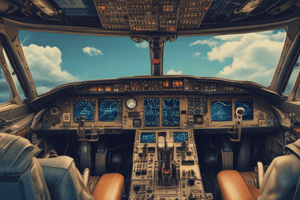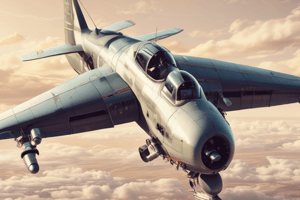Podcast
Questions and Answers
What is the primary purpose of using wing slats during landing or maneuvering close to stall?
What is the primary purpose of using wing slats during landing or maneuvering close to stall?
- To improve stability at high speeds
- To increase lift and drag (correct)
- To counteract nose-down pitching
- To reduce drag only
What is the main difference between automatic and powered slats?
What is the main difference between automatic and powered slats?
- Powered slats are controlled by the pilot (correct)
- Automatic slats are only used in low-speed aircraft
- Powered slats are simpler in design
- Automatic slats are more common in airliners
What is a Krueger flap?
What is a Krueger flap?
- A type of trailing edge flap
- A type of wingtip device
- A type of spoilers
- A type of leading edge flap (correct)
What is the benefit of using leading edge flaps in conjunction with trailing edge flaps?
What is the benefit of using leading edge flaps in conjunction with trailing edge flaps?
What is the purpose of a leading edge cuff?
What is the purpose of a leading edge cuff?
What happens to drag as greater amounts of flaps are extended?
What happens to drag as greater amounts of flaps are extended?
What is the function of a ruddervator in an airplane?
What is the function of a ruddervator in an airplane?
What happens when the control stick/yoke is pulled in an airplane with ruddervators?
What happens when the control stick/yoke is pulled in an airplane with ruddervators?
What is an elevon?
What is an elevon?
What happens when the right rudder pedal is pressed down in an airplane with ruddervators?
What happens when the right rudder pedal is pressed down in an airplane with ruddervators?
What type of aircraft often use elevons?
What type of aircraft often use elevons?
What is the function of a ruddervator when used as a rudder?
What is the function of a ruddervator when used as a rudder?
What is the effect of turning the control yoke/stick to the left?
What is the effect of turning the control yoke/stick to the left?
What is the purpose of a mixer in the design of flaperons?
What is the purpose of a mixer in the design of flaperons?
What is the primary function of flaps on an aircraft?
What is the primary function of flaps on an aircraft?
What happens when flaps are used during takeoff?
What happens when flaps are used during takeoff?
What is the recommended amount of flaps on takeoff for a Cessna 172?
What is the recommended amount of flaps on takeoff for a Cessna 172?
What is the effect of fully extending flaps for landing?
What is the effect of fully extending flaps for landing?
Flashcards are hidden until you start studying
Study Notes
Movable Wing Slats
- Movable wing slats are used during landing or maneuvers that approach the stall, but are retracted in normal flight to minimize drag.
- Types of wing slats include:
- Automatic: extend as the angle of attack (AOA) increases.
- Fixed: permanently extended, often used on specialist low-speed aircraft or for simplicity.
- Powered: controlled by the pilot, commonly used on airliners.
Leading Edge Flaps/Krueger Flaps
- Hinged flaps that fold out from under the wing's leading edge, increasing camber and thickness.
- Invented by Werner Krüger in 1943 and evaluated in Goettingen.
- Found on many modern swept wing airliners.
- Often used in conjunction with trailing edge flaps to reduce nose-down pitching.
- As flaps are extended, drag increases at a greater rate than lift.
Aircraft Flight Controls
- Unusual/dual purpose controls include:
- Ruddervators
- Elevons
- Flaperons
- Stabilator
Ruddervators
- A movable airfoil at the trailing edge of a V-tail airplane.
- Performs functions of both a rudder and an elevator.
- For elevator control, both moving surfaces move up and down in the same direction.
- For rudder control, both moving surfaces move in opposite directions.
- As elevator, pulling the control stick/yoke causes the tail to move downward, pitching the nose up.
- As elevator, pushing the control stick/yoke causes the tail to move upward, pitching the nose down.
- As rudder, pressing the right rudder pedal causes the tail to move to the left, yawing to the right.
- As rudder, pressing the left rudder pedal causes the tail to move to the right, yawing to the left.
Elevons
- Combine functions of elevator and aileron.
- Frequently used on tailless aircraft like flying wings/Delta wings.
- Installed on each side of the aircraft at the trailing edge of the wing.
- Turning the control yoke/stick to the left causes the left flaperon to move up and right flaperon down, making the plane roll to the left.
Flaperons
- Pilot controls for lowering or raising the flaperons are separate from those controlling the aileron function.
- A mixer is incorporated in the design to combine the two pilot inputs appropriately.
Secondary Flight Controls
- Wing Flaps
- Leading Edge Devices
- Spoilers
- Trim Systems
Flaps
- Devices used to improve lift characteristics of a wing.
- Mounted on the trailing edges of the wings of a fixed-wing aircraft.
- Reduce the speed at which the aircraft can be safely flown and increase the angle of descent for landing.
- Shorten takeoff and landing distances.
- When used during takeoff, flaps trade runway distance for climb rate.
- The amount of flap used on takeoff is specific to each type of aircraft.
- Flaps may be fully extended for landing to give the aircraft a lower stall speed, allowing for a slower approach and shorter landing distance.
Studying That Suits You
Use AI to generate personalized quizzes and flashcards to suit your learning preferences.



